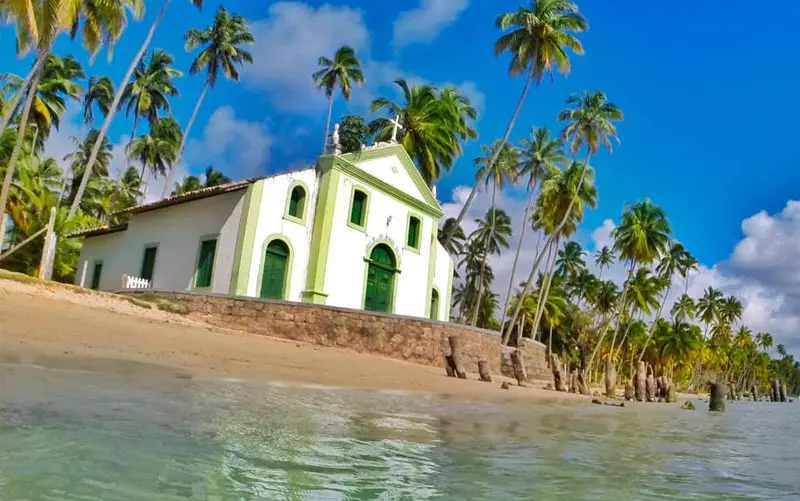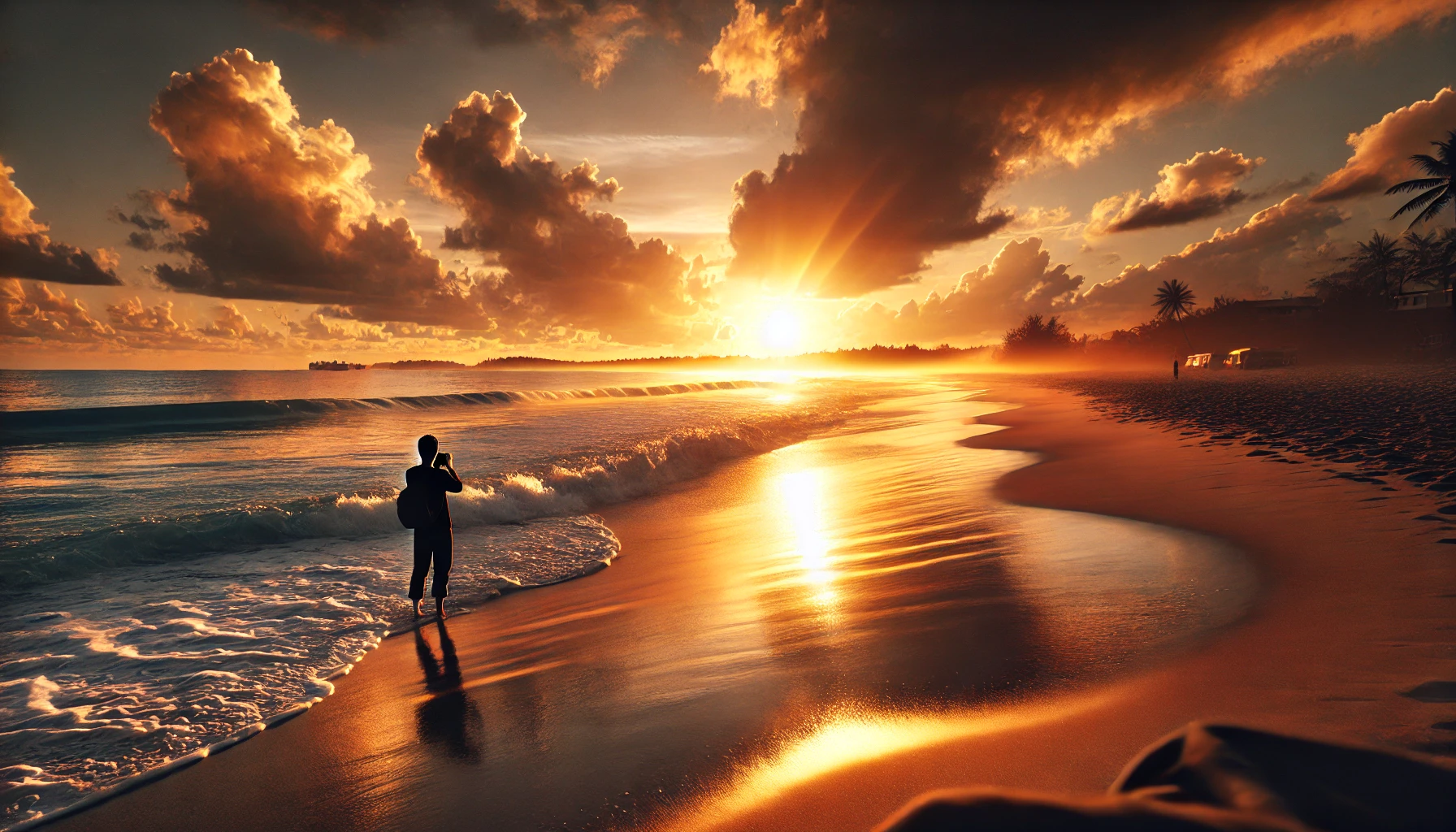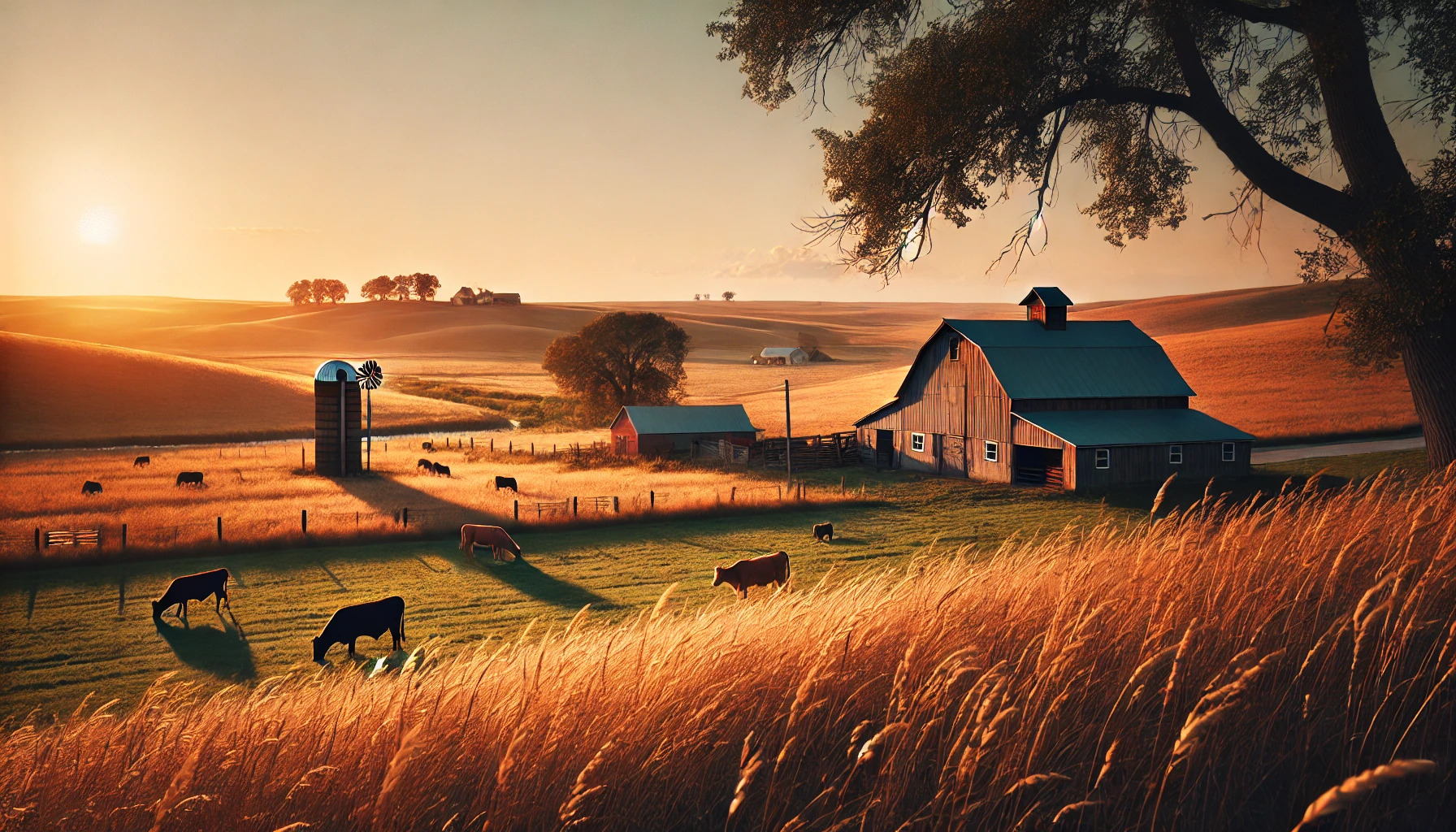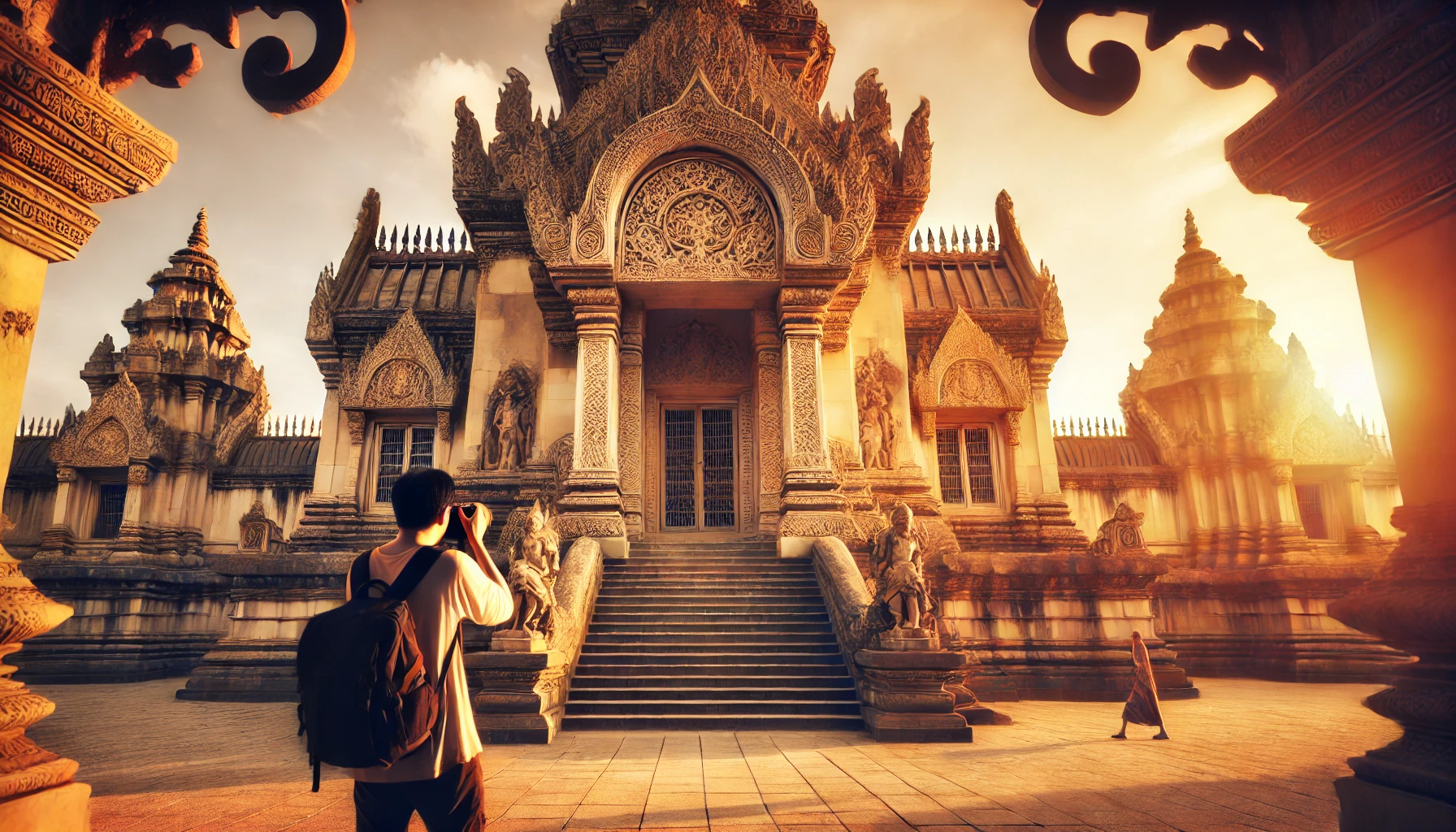Praia dos Carneiros, located in the state of Pernambuco in northeastern Brazil, is one of the most stunning destinations on the Brazilian coast. Known for its crystal-clear waters, idyllic coconut tree-lined beaches, and unparalleled tranquility, Praia dos Carneiros stands out as a true retreat for those seeking the perfect combination of natural beauty and peacefulness. Let’s explore what makes this beach one of the most incredible destinations in the Northeast.
Location and Access
Praia dos Carneiros is located in the municipality of Tamandaré, approximately 100 km south of Recife, the capital of Pernambuco. To reach the beach, visitors can drive to the municipality and then take local roads leading to the beach access point.
Although Praia dos Carneiros is a popular tourist destination, it retains a peaceful atmosphere, as the region still preserves the characteristics of a more secluded paradise, away from large crowds.
Natural Features
The main feature of Praia dos Carneiros is its scenic beauty. The beach is surrounded by coconut groves stretching along the shoreline, creating a postcard-worthy scene. Its waters are calm, crystal-clear, and turquoise, perfect for relaxing baths and water activities.
Another highlight of the beach is the coral reef formations close to the shore, which create natural pools, providing a spectacular natural display and making the spot ideal for snorkeling and diving. During low tide, the natural pools become even more evident, allowing visitors to walk over the shallow and transparent seabed.
Church of São Benedito
One of the icons of Praia dos Carneiros is the Church of São Benedito, located by the seaside. Built in the 18th century, this church is an important historical landmark in the region and adds a cultural touch to the beach’s idyllic setting. With its rustic charm and privileged location, the Church of São Benedito is one of the most photographed spots by tourists and an ideal place for contemplation. It is also the venue for weddings and other religious ceremonies, attracting many visitors.
Activities and Attractions
Praia dos Carneiros offers various activities for those who wish to explore its natural beauty and enjoy the serene atmosphere of the area:
- Boat Tours: One of the most popular attractions in the region is boat tours, which take visitors to the natural pools where they can swim in clear waters and observe marine life. Some tours also offer the opportunity to visit the uninhabited Santo Aleixo Island, a small island near the beach.
- Snorkeling and Diving: The natural pools of Praia dos Carneiros are perfect for snorkeling and diving. The coral reefs that form the pools are home to various colorful fish, offering an unforgettable experience for lovers of the sea and underwater life.
- Walking along the Shoreline: For those seeking tranquility, walking along the beach is a great way to enjoy the stunning beauty of the surroundings. Walking under the shade of the coconut trees, with the sound of the sea in the background, is a unique and relaxing experience.
- Local Cuisine: The local cuisine is another attraction of the region, with highlights being traditional Northeastern dishes such as delicious fish moqueca (stew), fresh shrimp, and seafood. Seaside restaurants offer stunning views for visitors while they savor local dishes.
Environmental Preservation
Praia dos Carneiros is known for its commitment to environmental preservation. Many areas of the beach are hard to access, which helps keep the location protected and untouched. Additionally, the area has conservation policies in place to ensure that the natural beauty of the place is preserved for future generations.
Environmental awareness is a key component, and many tours and activities promote respect for nature and local ecosystems. Sustainable tourism has been a cornerstone of the development of Praia dos Carneiros, allowing visitors to enjoy the place while respecting the environment.
Popular with Couples and Families
In addition to being a destination sought after by tourists looking for relaxation, Praia dos Carneiros is also one of the preferred locations for weddings and honeymoons due to its romantic and idyllic setting. The calm waters, coconut trees, and natural beauty create the perfect environment for celebrating special moments in a breathtaking scenario.
For families, Praia dos Carneiros is also a great destination, offering leisure options for all ages, from water sports to moments of relaxation under the coconut trees.
Conclusion
Praia dos Carneiros is undoubtedly one of the most enchanting destinations in northeastern Brazil. With its crystal-clear waters, lush coconut groves, natural pools, and the charming Church of São Benedito, the beach offers a true paradise for those seeking rest, natural beauty, and tranquility. Whether for those seeking aquatic adventures, relaxation by the sea, or a romantic setting, Praia dos Carneiros is the perfect destination for those wanting to connect with nature and experience unforgettable moments.

Praia do Futuro: The Most Famous Beach in Fortaleza
Praia do Futuro, located in Fortaleza, Ceará, is one of the most well-known and visited beaches in Brazil. Recognized for its beauty, infrastructure, and famous beach bars offering a mix of gastronomy, leisure, and comfort, Praia do Futuro is the ideal place for those seeking both fun and relaxation in one of the most incredible settings in the Northeast.
Location and Access
Praia do Futuro is located about 10 km from downtown Fortaleza, in the eastern part of the city, making it easily accessible by public transport, taxis, and private cars. Its proximity to the city center makes it a popular destination for both tourists and locals, offering excellent infrastructure with hotels, restaurants, and leisure options.
Natural Features
Praia do Futuro is famous for its clear and warm waters, which are perfect for bathing and water sports like surfing. The beach’s waves are highly appreciated by surfers, especially in the areas further from the shore. The beach’s sand is wide, golden, and well-maintained, offering ample space for relaxation or physical activities.
Fortaleza’s warm and sunny climate for most of the year makes Praia do Futuro a perfect destination for those who want to enjoy the heat of the Brazilian Northeast. The sea is calm and pleasant, making the beach accessible for people of all ages.
Beach Bars
One of the main attractions of Praia do Futuro is its famous beach bars. These structures function as real leisure and gastronomic centers, offering visitors a wide variety of typical Northeastern dishes such as fish, shrimp, sun-dried beef, and the traditional “baião de dois.”
The beach bars are equipped with infrastructure to make the visitor’s experience even more comfortable, with options like loungers, hammocks, umbrellas, showers, and even pools. In addition, many of them feature live music and events that ensure fun for both tourists and locals. Some of the most well-known beach bars include Barraca do Caranguejo, Crocobeach, and Barraca do Cebolinha.
Activities and Attractions
Praia do Futuro offers a variety of activities for those who want to make the most of their day at the beach:
- Surfing and Stand Up Paddle: The waves at Praia do Futuro are ideal for surfing, and the beach is a popular spot for local and visiting surfers. In addition, stand-up paddleboarding is also a popular activity, allowing visitors to enjoy the calm waters of the beach.
- Buggy Rides: Buggy rides are a main attraction at Praia do Futuro, taking tourists to explore other beautiful beaches in the region, such as Praia das Fontes and Praia do Morro Branco. During the ride, visitors can admire the dunes and natural landscapes of the Ceará coastline.
- Local Cuisine: In addition to the famous beach bars, Praia do Futuro is an excellent destination for food lovers. Seaside restaurants offer a variety of options, with dishes typical of Ceará and the Northeast, such as grilled fish, shrimp, lobsters, and seafood dishes. Refreshing drinks like cashew juice and traditional coconut water are also part of the gastronomic experience.
- Fishing and Boat Tours: For those seeking a more tranquil experience, boat tours and fishing activities are available. The area around Praia do Futuro is rich in marine life, providing great opportunities for amateur fishermen.
Nightlife
Praia do Futuro’s nightlife is also quite lively, with various bars and music venues. Some establishments feature live music, particularly forró, samba, and other traditional rhythms from the Northeast, creating a vibrant atmosphere for those wishing to enjoy the night in Fortaleza.
Being close to the center of Fortaleza also ensures easy access to other entertainment options in the city, such as theaters, restaurants, and bars. Therefore, it’s possible to enjoy the tranquility of the beach during the day and have fun with the various cultural attractions of the city at night.
Environmental Preservation
Despite being a very popular tourist destination, Praia do Futuro has been focusing on environmental preservation. Some of the beach bars follow sustainable practices, such as conscious water use and waste recycling, in addition to promoting educational campaigns about the importance of preserving the marine environment.
However, as with many beaches in Brazil, the increase in tourism brings challenges related to preservation. Therefore, it is essential for visitors to contribute to keeping the location clean and respecting environmental rules, ensuring that Praia do Futuro remains a paradise for future generations.
Conclusion
Praia do Futuro is undoubtedly one of the main postcards of Fortaleza and one of the most sought-after destinations in Ceará. With its beautiful scenery, calm waters, leisure infrastructure, and quality gastronomy, the beach offers a complete experience for those visiting the city. Whether for relaxation, water sports, savoring delicious local food, or enjoying the vibrant nightlife, Praia do Futuro is the ideal place for those wanting to experience the best of the Northeast coast.

Mirante de São Gonçalo: An Unforgettable View in the Heart of Alagoas
The Mirante de São Gonçalo, located in the state of Alagoas, is one of the most charming tourist spots in the region. Offering a breathtaking panoramic view, this location stands out as an excellent destination for those looking to admire the natural and cultural beauty of Northeast Brazil.
Location and Access
The Mirante de São Gonçalo is situated in the city of Penedo, one of the oldest and most historic cities in Alagoas, located on the banks of the majestic São Francisco River. Access to the viewpoint is relatively easy, either by car or on foot for those who enjoy a pleasant walk through the city’s historic streets.
Penedo is approximately 160 km from Maceió, the state capital, making it a great destination for visitors who want to explore Alagoas’ rich culture and natural landscapes.
A Panoramic View of the São Francisco River
The main attraction of Mirante de São Gonçalo is the privileged view it provides. From the top, visitors can admire the São Francisco River, which cuts through the landscape with its imposing waters, as well as the charming colonial buildings of Penedo.
During sunset, the experience becomes even more special as golden hues reflect on the river, creating a spectacular scene for photography and unforgettable moments.
History and Culture
In addition to its natural beauty, the viewpoint is also close to several historic sites in Penedo. The city boasts a rich architectural heritage, with centuries-old churches, museums, and colonial mansions that tell the story of Portuguese settlement in the region.
One of the highlights is the Church of São Gonçalo Garcia, built in the 17th century, which is located near the viewpoint. This religious site is one of the most important historical buildings in the city and holds great significance for locals and worshippers.
Activities at the Viewpoint
Visitors to Mirante de São Gonçalo can enjoy a variety of activities, such as:
- Photography: With its spectacular scenery, the viewpoint is the perfect place to capture stunning images, especially at sunrise and sunset.
- Nature Observation: The viewpoint offers a privileged view of the São Francisco River, allowing visitors to observe passing boats and the lush vegetation surrounding the area.
- Walking Tours: Since it is close to Penedo’s historic center, the viewpoint can be included in a walking tour itinerary to explore the city’s cultural and historical attractions.
Tips for Visiting
- Best time to visit: Sunset is one of the most recommended times to visit the viewpoint, as the landscape becomes even more stunning.
- Wear light clothing: Penedo’s climate is usually warm and sunny, so it’s best to wear comfortable clothes and bring water to stay hydrated.
- Enjoy the local cuisine: After visiting the viewpoint, take the opportunity to explore the city’s restaurants and try traditional dishes such as peixada alagoana (Alagoas-style fish stew) and sururu (a dish made with local shellfish).
Conclusion
The Mirante de São Gonçalo is an unmissable destination for those visiting Penedo, offering the perfect blend of history, culture, and nature. With a stunning view of the São Francisco River and a peaceful atmosphere for contemplation, it is one of the most charming tourist attractions in Alagoas.
If you are looking for a special place to admire the beauty of Northeast Brazil and experience a bit of the country’s history, Mirante de São Gonçalo is the perfect choice!

Museu Náutico da Bahia: History and Culture by the Sea
The Museu Náutico da Bahia, located within the iconic Forte de Santo Antônio da Barra, is one of the most important maritime museums in Brazil. Situated in Salvador, the capital of Bahia, the museum houses a rich collection that tells the history of navigation, coastal defense, and Brazil’s relationship with the sea over the centuries. Additionally, it offers one of the most breathtaking views in the city, making it a must-visit destination for tourists and history enthusiasts.
Location and Access
The Museu Náutico da Bahia is located at the Farol da Barra, one of Salvador’s most famous landmarks. The fort where the museum is housed was built in the 16th century and is considered the oldest fort in Brazil. Its strategic position at the entrance of the Baía de Todos-os-Santos (Bay of All Saints) provided protection against invaders and pirates who threatened the Brazilian coast during colonial times.
The museum is easily accessible by car, public transportation, or even on foot for those staying in the Barra district. It is close to other major attractions, such as Porto da Barra and the historic Pelourinho, making it an essential stop for visitors exploring the city.
The Museum’s Collection
The Museu Náutico da Bahia features a fascinating collection covering different periods of Brazil’s maritime history. Highlights include:
- Ancient Nautical Instruments: Compasses, astrolabes, and sextants used by Portuguese navigators in the 16th and 17th centuries.
- Historical Maps and Cartography: Old maps showing the evolution of geographic knowledge of the Brazilian coast and the South Atlantic.
- Underwater Archaeological Artifacts: Shipwreck remains, including cannons, anchors, and ceramics recovered from the ocean floor.
- Replica Ships: Miniature models of caravels, galleons, and other vessels that played a role in Brazil’s navigation history.
- History of the Farol da Barra: Interactive panels and exhibits explaining the significance of the Farol da Barra, which has guided ships entering the Bay of All Saints since 1698.
In addition to its permanent collection, the museum also hosts temporary exhibitions and events focused on promoting maritime culture and naval history in Brazil.
The Museum Experience
A visit to the Museu Náutico da Bahia is an immersive journey through Brazil’s colonial past and its maritime explorations. The well-preserved fort, with its stone walls and cannons facing the sea, transports visitors back to a time of discoveries and naval battles.
Beyond the exhibits, one of the highlights of the visit is climbing to the top of the Farol da Barra, where you can enjoy a spectacular panoramic view of the Bay of All Saints and the Atlantic Ocean. The sunset from the lighthouse is considered one of the most beautiful in Salvador, making it a must-see experience.
Interesting Facts about the Museum and the Fort
- The Forte de Santo Antônio da Barra was originally built by the Portuguese in 1598 and has been renovated over the centuries.
- The Farol da Barra was the first lighthouse in the Americas and is one of the oldest still in operation in the world.
- The Bay of All Saints was a crucial route for arriving ships during the colonial period and played an essential role in the sugar and gold trade.
Tips for Visiting
- Opening Hours: The museum is open daily, but it’s a good idea to check the latest schedules before visiting.
- Entrance Fee: There is an admission fee, but it is affordable and well worth the cultural and historical experience.
- Best Time to Visit: Late afternoon is ideal to witness the breathtaking sunset at the Farol da Barra.
- Photography: The fort and lighthouse provide incredible photo opportunities, so bring your camera or smartphone.
- Explore the Surroundings: After visiting the museum, take a stroll along the Barra waterfront and explore other attractions in Salvador.
Conclusion
The Museu Náutico da Bahia is a true treasure of Brazilian maritime history and culture. Located in the emblematic Farol da Barra, it offers a unique experience for those interested in navigation, coastal defense, and the historical importance of the sea for Brazil’s development.
With an impressive collection, stunning ocean views, and a historic setting, the museum is a must-visit attraction for anyone exploring Salvador. Whether you are eager to learn about Brazil’s naval past or simply wish to enjoy one of the most beautiful sunset views in the city, the Museu Náutico da Bahia is the perfect destination.

Lençóis Maranhenses National Park: The Brazilian Desert with Crystal-Clear Lagoons
The Lençóis Maranhenses National Park, located in the state of Maranhão, is one of the most stunning landscapes in Brazil and the world. With its vast white sand dunes interspersed with freshwater lagoons in shades of blue and green, the park offers a unique scenery that transforms with each season.
This natural paradise attracts tourists from all over the world in search of adventure, connection with nature, and breathtaking landscapes.
Location and Access
The park is located on the coast of Maranhão, covering the municipalities of Barreirinhas, Santo Amaro do Maranhão, and Primeira Cruz. The main access point is the city of Barreirinhas, about 250 km from the capital, São Luís.
Visitors can reach Barreirinhas by road from São Luís, with options including buses, vans, and private cars. From the city, 4×4 vehicle tours take tourists to the dunes and lagoons.
The Landscape of Lençóis Maranhenses
The Lençóis Maranhenses National Park spans an area of 155,000 hectares, featuring a vast desert of moving sand dunes that can reach up to 40 meters in height. What makes this park truly unique are its seasonal lagoons, which form during the rainy season, between January and June, when rainwater fills the depressions between the dunes, creating true oases.
During the dry season, some lagoons disappear, while others—deeper ones—remain full year-round, such as the famous Lagoa Azul (Blue Lagoon) and Lagoa Bonita (Beautiful Lagoon).
Top Attractions
Lençóis Maranhenses offers a variety of unforgettable experiences. Some of the main attractions include:
1. Lagoa Azul and Lagoa Bonita
These are the park’s most visited lagoons, known for their crystal-clear waters and towering dunes surrounding them. Lagoa Bonita offers a breathtaking panoramic view of the region.
2. Canto do Atins
Located near the ocean, Canto do Atins is famous not only for its beautiful dunes and lagoons but also for the delicious shrimp dishes served in local restaurants.
3. Preguiças River and Vassouras
A boat trip along the Preguiças River takes visitors to riverside communities, such as Vassouras, where you can see capuchin monkeys and explore the Pequenos Lençóis (Small Lençóis), a smaller version of the park’s large dunes.
4. Lagoa da Esperança
This is one of the few lagoons that remain full throughout the year, making it a great spot for a refreshing swim amidst the dunes.
5. Aerial Tour Over the Park
One of the most unforgettable experiences is taking a scenic flight over the park, offering a spectacular aerial view of the dunes and lagoons.
Best Time to Visit
The best time to visit Lençóis Maranhenses is between June and September, when the lagoons are full and the weather is still mild. During this period, the contrast between the white sand and turquoise water creates a truly stunning landscape.
At the end of the year, from October to December, many lagoons have dried up, but the dunes still offer an impressive sight.
Activities in the Park
Besides admiring the landscapes, visitors can enjoy several activities at Lençóis Maranhenses, such as:
- Hiking on the dunes: Walk across the white sands and enjoy the breathtaking views.
- Swimming in the lagoons: Relax in the crystal-clear waters, especially in the most well-preserved lagoons.
- 4×4 tours: The only way to access the dunes and lagoons is with appropriate vehicles, ensuring an adventurous experience.
- Boat trips on the Preguiças River: Explore riverside villages and discover the local wildlife.
- Kitesurfing in Atins: The beach in Atins is one of the best spots in Brazil for this sport.
Flora and Fauna
Despite looking like a desert, Lençóis Maranhenses National Park is home to a rich biodiversity. Among the animals that inhabit the region are turtles, herons, fish, and even ocelots. The vegetation consists of restingas (coastal forests), mangroves, and cerrado (savanna-like biomes).
Tips for Visiting
- Bring sunscreen and a hat: The sun at Lençóis Maranhenses is intense, so sun protection is essential.
- Wear light, comfortable clothing: The heat and wind can be strong, so opt for fresh, breathable outfits.
- Prepare for walking: Some dune trails require moderate physical effort.
- Carry cash: Some areas in the park have limited internet access for digital payments.
- Respect the environment: Avoid littering and help preserve the lagoons and local wildlife.
Conclusion
The Lençóis Maranhenses National Park is one of the most spectacular places in Brazil, blending the vastness of a desert with the unique beauty of freshwater lagoons. Its cinematic landscapes and the feeling of being in an untouched paradise make it an unforgettable destination.
Whether you want to explore the dunes, swim in crystal-clear lagoons, or simply admire one of the most breathtaking natural settings in the world, Lençóis Maranhenses is a must-visit destination in Northeastern Brazil that every traveler should experience at least once in their lifetime.

Tourist Spots to Photograph: Farol da Barra (BA), Rio Preguiças (MA), Pequenos Lençóis (MA), Mandacaru (MA), Praia de Caburé (MA)
These are excellent tourist spots for photography! Here are some suggestions on what to capture in each of them to ensure stunning photos:
1. Farol da Barra (BA) – Salvador, Bahia
What to photograph?
- The Farol da Barra (Barra Lighthouse) with the sunset in the background (one of the most beautiful in Brazil!).
- The panoramic view of the Baía de Todos-os-Santos (Bay of All Saints).
- Waves crashing on the rocks around the lighthouse.
- The historic structure of the Forte de Santo Antônio da Barra, where the lighthouse is located.
Best time for photos: Late afternoon to capture the incredible sunset.
2. Rio Preguiças (MA) – Maranhão
What to photograph?
- The reflection of palm trees and vegetation on the river’s waters.
- Regional boats navigating the river, creating stunning compositions.
- The meeting point of the river and the sea near Atins.
- Local fishermen and their traditional boats.
Best time for photos: Early morning or late afternoon to avoid harsh lighting.
3. Pequenos Lençóis (MA) – Maranhão
What to photograph?
- The smaller dunes, which create a landscape similar to the Lençóis Maranhenses, but on a smaller scale.
- Small lagoons formed between the dunes.
- Footprints in the sand at sunrise or sunset, creating a beautiful light and shadow effect.
Best time for photos: Sunrise or sunset to capture the interplay of light and shadows on the dunes.
4. Mandacaru (MA) – Maranhão
What to photograph?
- The iconic Mandacaru Lighthouse, offering a spectacular view of the Rio Preguiças and dunes.
- The colorful fishermen’s village and its charming houses.
- The sunset seen from the top of the lighthouse.
Best time for photos: Late afternoon to capture the sunset from the top of the lighthouse.
5. Praia de Caburé (MA) – Maranhão
What to photograph?
- The contrast between the river and the ocean, as this beach is located between the Rio Preguiças and the Atlantic Ocean.
- The sunset reflecting on the river’s waters.
- The small rustic restaurants and guesthouses by the sea.
- Local wildlife, such as birds and crabs on the sand.
Best time for photos: Sunset, when the sky reflects on the water and the light turns golden.







